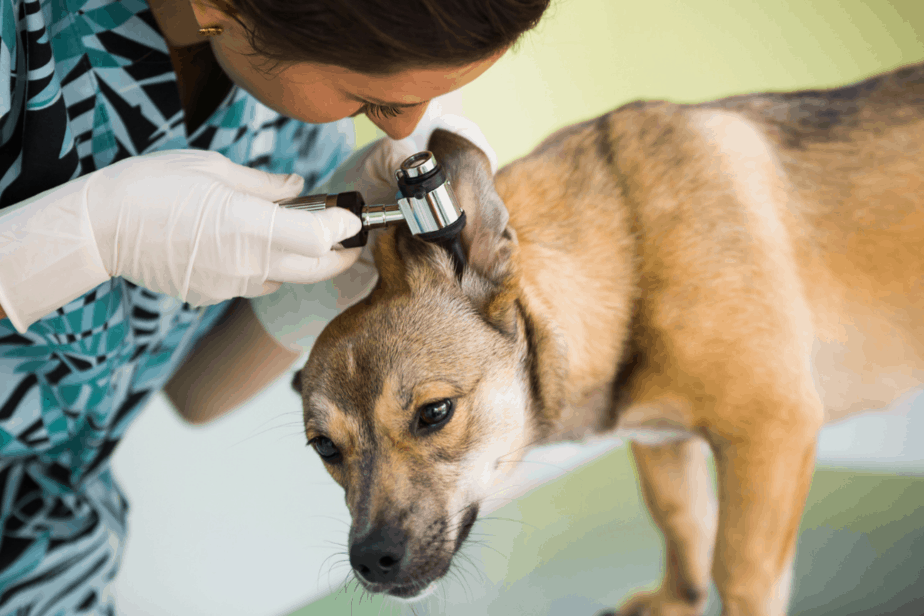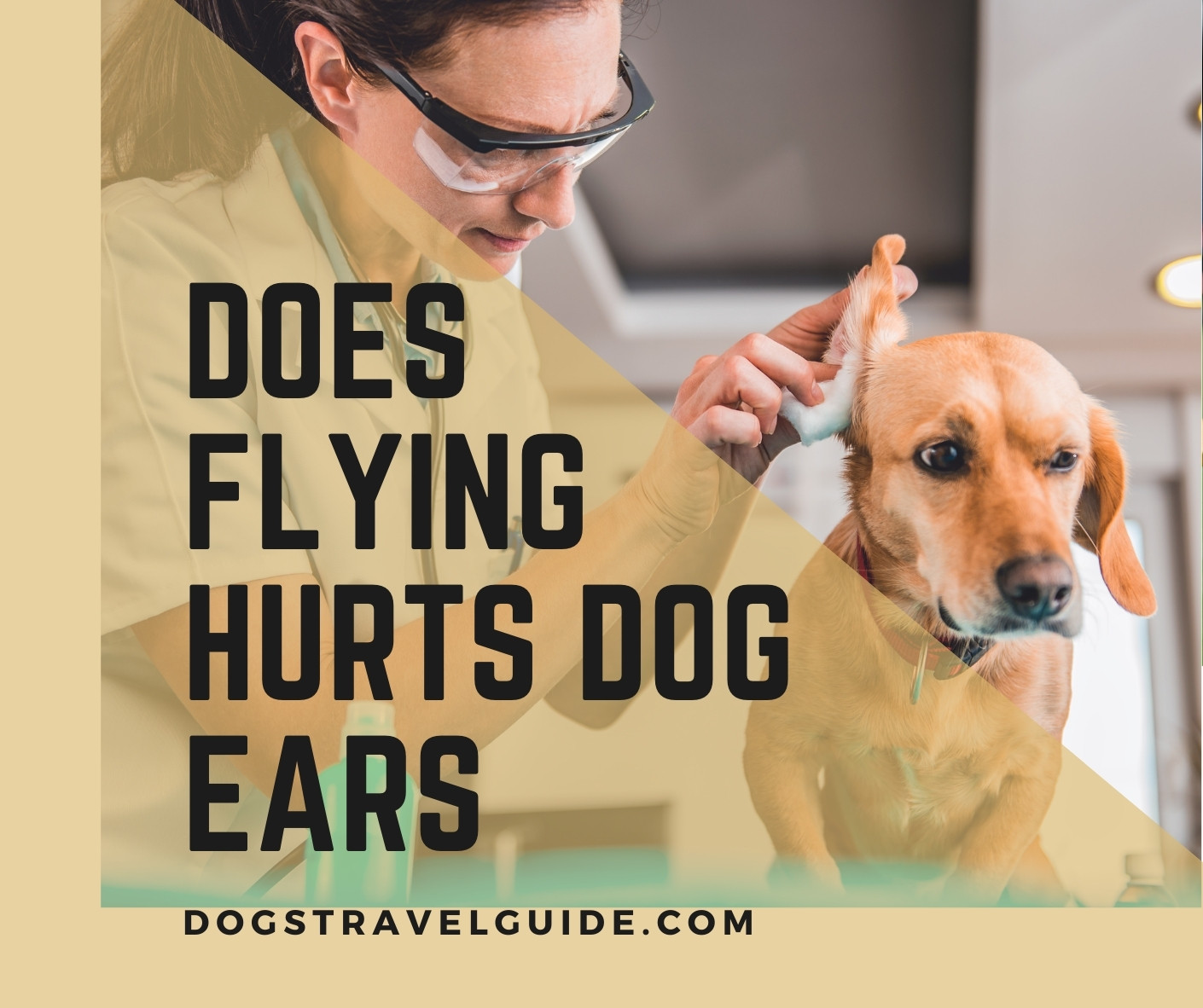The debate about whether or not flying with your dog is safe has been raging on for years. We found that most people tend to think it’s just fine, but there are others that wonder if flying can hurt the dog’s ears?
Well, the short answer is dogs can experience things like popping in the ears and temporary hearing loss when flying at 30,000 feet! Although this may feel slightly uncomfortable for the dog it won’t be painful nor will it cause any permanent damage!
Unfortunately, there are no studies on whether or not flying can hurt the dog’s ears.
However, when a person is flying on an airplane their eardrums pop during takeoff and landing, which can lead to temporary hearing loss.
So what does this mean for our four-legged friends? It means without any scientific evidence we simply cannot know how the dog ears would be affected by air travel.
However, we can take a closer look at the main reasons why dogs’ ears pop and whether or not the dog experiences temporary hearing loss like us humans!
Dogs Ears Side Effects At High Altitude
Dogs are more susceptible to the effects of high altitude. They can also sense when there is an adjustment to changes in air pressure which can lead to the dog barking on the plane.
A dog’s ear will be more sensitive to this change that can give them slight discomfort. The reason for this is when pressure levels change rapidly the dog’s ear will have a problem equalizing.
The same thing happens to us humans when the plane starts climbing and then there’s a change in pressure you may of notice that your ears start popping.
Ears Popping
If your dog hasn’t experienced this before then it may startle them!
However, the dog’s ears will naturally equalize this happens usually after a few minutes, just until the air has balanced out in the inner eardrum.
As your dog’s ears are obviously a little different from ours, it is thought that the outer ear canal can act as an equalizer for pressure.
This lets some of the air escape through tiny tubes in order to make up for any differences between atmospheric and inner-ear pressures.
When this happens dogs tend to bark to reduce or to try and stop it from happening.
Much like when we humans yawn or swallow which in most cases does actually help.
Temporary Hearing Loss
We all know that airplane travel can be stressful on our pets, but did you know that your dog may also experience temporary hearing loss during takeoff and landing?
Now, when we say hearing loss we don’t mean that your dog will be completely deaf, not at all. It’s more like trying to hear underwater and this can last for only seconds or a few minutes.
But once your dog’s ears adjust then there will be able to hear properly. We humans can also experience this which is usually fixed by simply coughing or yawning!
You may also notice that your dog is shaking his head side to side like they do the shake themselves dry!
If you see this don’t be alarmed this is just their way to reduce any discomfort if their ears haven’t pop properly.
However, if your dog continues to shake his head or keeps scratching its ears or you see any redness and swelling of the ear canal then your dog could have an ear infection and should be seen by a veterinarian.

Aircraft Noise
One of the first things to think about is whether or not air travel with your pet may be too loud for them.
Dogs are particularly sensitive to high-pitched sounds, which can lead to ear damage.
The noise level onboard an aircraft varies depending on its size – a smaller plane will generally have higher levels than a larger one (due in part to engines being louder at takeoff).
Now, there are some pet owners who are concerned that loud noises like airplane engines can hurt the dog’s ears?
Well, although dog’s ears are more sensitive to noise there have been no reports of any dogs damaging their ears after flying.
With that said, all planes produce sufficient noise and if the dog is exposed to higher levels of sound over long periods of time then this could cause problems with its ears.
Noise Level On Small Planes
So what about small planes? does flying on small planes hurt the dog’s ears? The noise level onboard a smaller plane is definitely much quieter than that of larger planes.
If you have a dog who is afraid of the sound of planes, or you are worried that the noise may hurt the dog’s ears then you should consider flying on a small plane.
They are much quieter and can be more comfortable for your dog, however, because the plane is much smaller the number of dogs allowed on board will be very limited.
Also, smaller planes don’t need to travel as high in the clouds meaning that they are less likely to encounter as much turbulence or air pressure as you do on larger planes.
Protection For Dogs Ears
As a pet owner who travels with their dog a lot, you are probably wondering if there is any way to protect my pup’s ears when flying?
Well, we have some good news! Yes! there is a way you can protect your dog’s ears while flying.
Dogs are very sensitive to loud noises, and it is important that you take care of them when flying. Dogs have two different types of eardrums: the tympanic membrane and the oval window.
The tympanic membrane vibrates from a sound wave entering through the oval window, which then travels into the middle ear cavity to be transmitted to the cochlea where it can be interpreted as sound.
The tympanic membrane is like an eardrum in humans; when there is too much noise for too long, or if they are exposed to sudden intense sounds (like fireworks) it can cause flight pain in the eardrum.
This fragile tissue can become inflamed or injured causing hearing loss or tinnitus (ringing in your ears).
However, your dog is unlikely to experience this on a plane as the sound are not loud enough to cause any permanent damage.
So how can you protect your dog’s ears from the loud noises when flying?
Dog Ear Muffs
Dog ear muffs are perfect for protecting your dog from any loud noises they can endure on planes.
Not only do they look adorable on your pup, but they also provide extra warmth to help combat those cold winter temperatures.
These earmuffs are specially designed for the shape of your dog ears so they won’t have any issues wearing them.
You’ll also enjoy knowing that these dog ear muffs and their insulation helps your dog sleep much better when flying.
Dog Ear Hood
You can also use what’s called a Dog Ear Hood that covers your pet’s ears so it can dampen out any loud noises coming from the plane and won’t keep them restless or scared.
The dog-ear hood is a soft, flexible, and comfortable fabric. The material is made of cotton with an acrylic coating to provide extra protection for your pet!
When the noise gets too much, simply put their hood on and cover their ears, then your dog should be able to take a nap without the noises keeping your dog awake.
Sedation
If you have a dog that suffers from fear of loud noises, then being on a plane will be very uncomfortable for the dog, especially when their ears start popping for some dogs this can be very scared.
So to solve this you can sedate your dog, but not all airlines will allow you to board with a sedated dog so make sure you check with your airline first.
BEFORE SEDATION: It’s always recommended that you consult with your local veterinarian before you sedate your dog! As they can recommend and provide the correct medication.
You should also consider sedating your dog if they have a history of motion sickness, or get very nervous.
Most pets usually don’t need this additional treatment but it’s nice to know that there is a medicine available just in case they start freaking out once onboard the airplane!
Conclusion
So does flying hurt dogs’ ears? Well, as before there have been no reports of any dogs hurts their ears while flying,
however, as you have just read in this article the pressure changes and noise can be uncomfortable for some dogs.
If you are planning on flying with your pet, it’s important to know their reaction to being on a plane.
For some pets, this is a completely normal experience. But for other dogs, it can lead to anxiety and panic.
What makes this even more difficult is some dogs are unable to tell us when they are uncomfortable or hurt.
This means that it is up to you as the owner of a precious pup to protect their hearing by taking care of them responsibly.

